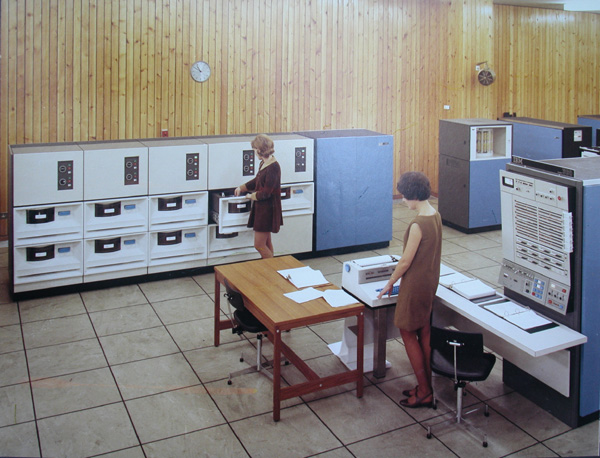
This is a bank of 2314 disk drives. There are nine of them and the blue control unit on the right.
Each drive was in a drawer that could be opened. Once open a cover could be screwed on to the disk pack,
which also released the pack from the drive, the cover and pack could be removed and a bottom cover fixed.
Above each drive was a panel containing a START/STOP switch, green drive READY light, and a socket for a circular plug.
There were eight plugs and each contained three magnets positioned to be address bits: 000 - 111 (0 - 8).
So only eight of the nine drives could be in use at any one time.
The procedure was to place the next disk pack to be used on the ninth drive.
When the computer operator decided that one of the disk packs in use was not needed,
a command would be given on the operator console to the operating system to logically unmount the disk pack.
When the address plug was moved from the unmounted drive to the pre-readied drive in about a second.
The whole bank of disk drives provided 240MBytes of storage, weighed 1950Kg, and consumed 9.1kVA of electricity.
We do not have a bank of 2314 disk drives in our collection, just some things smaller:
| Mus.Cat. NEWUC:2005.45 | Mnfctr: IBM | Date: 1966 | Ser. No: 70-14836 | Model: 2316 |
| Comp: Disk pack | Diameter: 378 mm | Height: 153 mm | Weight: 5.1 Kg |
This is a 2314 disk pack with its cover loosely placed on top.
This is the disk pack on its base cover with the top cover removed.
The disk pack contained eleven 14-inch disks separated by spacers.
The top surface of the top disk and bottom of bottom were not used,
so there were 20 recording surfaces.
This was twice the number of the 7.25MB 2311 disk pack
and along with a doubling of the recording density per track to 87 bits/mm gave a capacity of 29MB.
| Mus.Cat. NEWUC:2004.26 | Mnfctr: IBM | Date: 1966 | Ser. No: - | Model: - |
| Comp: Disk head | Length: 124mm | Width: 22mm | Depth: 5mm | Weight: 18g |
This is one of the twenty head/arm assemblies from a 2314 disk drive.
It is similar in size to the 2311 disk head assembly but the flying disk is not metal so making it lighter.
The position of the read/write head assembly was mechanically controlled at 4 tracks per millimeter.
Since these disk packs were removable and could be mounted on any drive it was important that the head
positioning was the same on each drive or data written on one drive would not able to be read on another.
As part of routine maintenance, which took place between 08:00 and 09:00 every weekday,
the IBM customer engineer would, amongst other things adjust the head positioning on each drive
by using pre-written data on a customer engineering disk pack.
This doubling of the bit density also doubled the data transfer rate to 2.5Mb/s.
The two bleed holes are still there, they provided lateral stability,
making the head something like a catamaran boat.
It was part of routine maintenance to clean the heads and the disks. The IBM customer engineer
wrapped some lint free cloth around a plastic spatular, soaked it in iso-propylalcohol and cleaned the heads.
If the head was dirty when removed it was coloured an iron-oxide red.
Similarly the disk packs would be mounted on an external spindle and each surface cleaned.